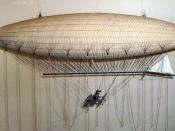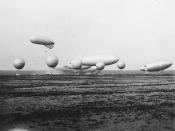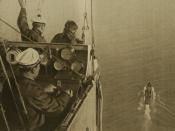Airships. In the early years of War, these beasts were known for their majestic presence in the sky and were icons of a country's power and prestige. They reigned mostly as reconnaissance and transport utility aircraft but there was something about this 'lighter-than-air' ship that made it far more than a mere utility workhorse. In this essay, I will discuss the ever-popular and ever-living king of the sky; the Airship.
Airships, or dirigibles, were developed from the free balloon. Three classes of airships are recognized: the non-rigid, commonly called blimp, in which the form of the bag is maintained by pressure of the gas; the semi-rigid airship, in which, to maintain the form, gas pressure acts in conjunction with a longitudinal keel; and the rigid airship, or zeppelin, in which the form is determined by a rigid structure. Technically all three classes may be called dirigible (Latin dirigere, 'to direct, to steer') balloons.
Equipped with a bag containing a gas such as helium or hydrogen which is elongated or streamlined to enable easy passage through the air, these Airships could reach speeds up to 10mph with a 5hp steam engine propeller.
The first successful airship was that of the French engineer and inventor Henri Giffard, who constructed in 1852 a cigar-shaped, non-rigid gas bag 44 m (143 ft) long, driven by a screw propeller rotated by a 2.2-kw (3-hp) steam engine. He flew over Paris at a speed of about 10 km/hr (about 6 mph). Giffard's airship could be steered only in calm or nearly calm weather. The first airship to demonstrate its ability to return to its starting place in a light wind was the La France, developed in 1884 by the French inventors Charles Renard and Arthur Krebs. It was driven by an electrically rotated propeller. The Brazilian...


